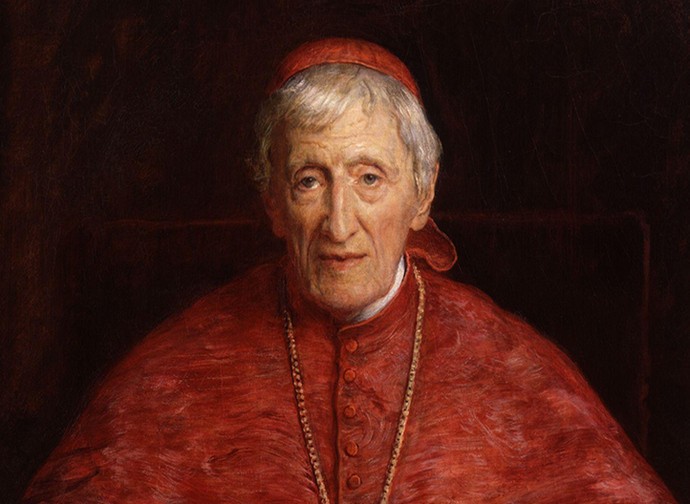Saint John Henry Newman
The liturgical memorial of St John Henry Newman (1801-1890) is celebrated today for a very special reason. Unlike most of the other saints, the great English theologian and cardinal is celebrated by the Church not on his dies natalis (the day of his birth into Heaven, i.e. his earthly death) but on the day of his conversion to Catholicism, which took place on 9 October 1845.

The liturgical memorial of St John Henry Newman (1801-1890) is celebrated today for a very special reason. Unlike most of the other saints, the great English theologian and cardinal is celebrated by the Church not on his dies natalis (the day of his birth into Heaven, i.e. his earthly death) but on the day of his conversion to Catholicism, which took place on 9 October 1845, when he was 44 and a half years old. Newman took that step, a real watershed in his life, after a long and troubled journey in search of the truth.
He was born to Anglican parents in London. His “first conversion”, as he called it, occurred when he was 15: this was when he dispersed his inner haze around God's existence and understood the emptiness of earthly things. Reading the Calvinist Thomas Scott helped with this; in particular these two phrases of his struck a chord with Newman: “Holiness rather than peace”; “Growth is the only proof of life”. In 1825 he became an Anglican pastor. In the following years he was one of the most prominent exponents of the Oxford Movement, which rejected religious Liberalism and aimed to renew Anglicanism along three fundamental lines: the principle of dogma, the sacraments, and the anti-Roman character. The latter emerged especially after accusations of “popery” were received by the most influential Anglican personalities.
For years, Newman believed that Anglicanism was the only faithful heir of the Church founded by Christ; however, further study of the writings of the Fathers and of the history of the early Christian centuries gradually convinced him that this fidelity only belonged to the Church of Rome. In 1843 he retracted all his attacks against it and renounced his office as Anglican minister. Because of the last doubts and his fear that the souls abandoned by him might fall into Liberalism, another two years passed before his final step. At this stage, when he was already at Littlemore College, he wrote the Development of Christian Doctrine, in which he explained how the “additions” made over the centuries by Catholic doctrine - and attacked by Protestants and Anglicans - were nothing more than the fruit of the gradual understanding of the truth already implicitly contained in the Holy Scriptures.
It was 9 October 1845, when, after five hours in the rain, the Blessed Dominic of the Mother of God (Domenico Barberi), an Italian Passionist who had heard an inner voice many years earlier telling him that he would be a victim for the conversion of England, passed through Littlemore. “I sat by the fire”, Father Domenico would later recall, “to dry out. The door opened and what an impression it made on me to see John Henry Newman suddenly appear, asking me to hear his confession so that he could be welcomed into the arms of the Church! And there, by the fire, he began his general confession with extraordinary humility and devotion”. The news of his conversion caused a great uproar.
Two years later Newman received priestly ordination in Rome and entered the Oratory of St Philip Neri, finding himself fully at ease with the charism of the saint who combined love for Jesus with care for his neighbour, joviality and culture. With the approval of Pius IX, he imported the Oratory into England. Many were the conversions he brought about, but he was also misunderstood and attacked from without and within the Church. His great contribution to the Bride of Christ finally gained solemn recognition over thirty years later, when Leo XIII offered him the cardinalate (Newman was the first on Pope Pecci's list of new cardinals).
On the day he was created cardinal, 12 May 1879, he delivered in Rome his famous Biglietto Speech, in which he analysed with prophetic lucidity the main evils of the contemporary age, from religious indifferentism to the reduction of faith to a private matter: “Liberalism in religion is the doctrine that there is no positive truth in religion, but that one creed is as good as another”. Another evil of Liberalism, warned Newman in his Speech, is to maintain that “Revealed religion is not a truth, but a sentiment and a taste; not an objective fact, not miraculous; and it is the right of each individual to make it say just what strikes his fancy”.
In Newman's thought the inseparable link between conscience and truth is clear, which means that the former - correctly understood - can never give in to relativism. As the then Cardinal Joseph Ratzinger explained in 1990, “Newman taught that conscience had to be nurtured as a way of obedience to objective truth”, therefore to God. The synthesis he developed between faith and reason was also admirable, rejecting the opposite errors of fideism and rationalism. He was convinced that evangelization and education must proceed together. He considered the role of the laity to be fundamental and said that he wanted lay people “who know their religion, [...] who know what they believe and what they do not believe, who know their creed so well that they can account for it, who know history so well that they can defend it”.
In the light of so much healthy doctrine, one can understand the enormous esteem nurtured by many pontiffs for the great English convert. Among them Pius XII, who one day said to Jean Guitton: “Do not doubt, Newman will one day be a doctor of the Church”.


